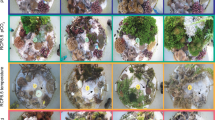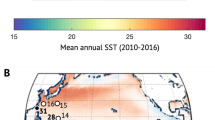Abstract
Increasing atmospheric carbon dioxide (CO2) concentrations are expectedto decrease surface ocean pH by 0.3–0.5 units by 2100 (refs 1, 2), lowering the carbonate ion concentration of surfacewaters. This rapid acidification is predicted to dramatically decrease calcification in many marine organisms3,4. Reduced skeletal growth under increased CO2 levels has already been shown for corals, molluscs and many other marine organisms4,5,6,7,8,9. The impact of acidification on the ability of individual species to calcify has remained elusive, however, as measuring net calcification fails to disentangle the relative contributions of gross calcification and dissolution rates on growth. Here, we show that corals and molluscs transplanted along gradients of carbonate saturation state at Mediterranean CO2 vents are able to calcify and grow at even faster than normal rates when exposed to the high CO2 levels projected for the next 300 years. Calcifiers remain at risk, however, owing to the dissolution of exposed shells and skeletons that occurs as pH levels fall. Our results show that tissues and external organic layers play a major role in protecting shells and skeletons from corrosive sea water, limiting dissolution and allowing organisms to calcify10,11. Our combined field and laboratory results demonstrate that the adverse effects of global warming are exacerbated when high temperatures coincide with acidification.
This is a preview of subscription content, access via your institution
Access options
Subscribe to this journal
Receive 12 print issues and online access
$209.00 per year
only $17.42 per issue
Buy this article
- Purchase on Springer Link
- Instant access to full article PDF
Prices may be subject to local taxes which are calculated during checkout





Similar content being viewed by others
References
Caldeira, K. & Wickett, M. E. Anthropogenic carbon and ocean pH. Nature 425, 365 (2003).
Orr, J. C. et al. Anthropogenic ocean acidification over the twenty-first century and its impact on calcifying organisms. Nature 437, 681–686 (2005).
Kleypas, J. A. et al. Impact of Ocean Acidification on Coral Reefs and Other Marine Calcifiers: A Case Guide for Future Research (Report of a workshop held 18–20 April 2005, St. Petersburg, FL, sponsored by NSF, NOAQA, and US Geological Survey, 2006).
Kroeker, K., Kordas, R. L., Crim, R. N. & Singh, F. G. Meta-analysis reveals negative yet variable effects of ocean acidification on marine organisms. Ecol. Lett. 13, 1419–1434 (2010).
Gattuso, J-P., Allemand, D. & Frankignoulle, M. Photosynthesis and calcification at cellular, organismal and community levels in coral reefs: A review on interactions and control by carbonate chemistry. Am. Zool. 39, 160–183 (1999).
Silverman, J. et al. Coral reefs may start dissolving when atmospheric CO2 doubles. Geophys. Res. Lett. 36, L05606 (2009).
Gazeau, F. et al. Impact of elevated CO2 on shellfish calcification. Geophys. Res. Lett. 34, L07603 (2007).
Fabricius, K. E. et al. Losers and winners in coral reefs acclimatized to elevated carbon dioxide concentrations. Nature Clim. Change 1, 165–169 (2011).
Cohen, A. L. et al. Morphological and compositional changes in the skeletons of new coral recruits reared in acidified seawater: Insights into the biomineralization response to ocean acidification. Geochem. Geophys. Geosyst 10, Q07005 (2009).
Ries, J., Cohen, A. & McCorkle, D. Marine calcifiers exhibit mixed responses to CO2-induced ocean acidification. Geology 37, 1131–1134 (2009).
Tunnicliffe, V. et al. Survival of mussels in extremely acidic waters on a submarine volcano. Nature Geosci. 2, 344–348 (2009).
Wood, H. L., Spicer, J. I. & Widdicombe, S. Ocean acidification may increase calcification rates, but at a cost. Proc. R. Soc. B 275, 1767–1773 (2008).
Jury, C. P., Whitehead, R. F. & Szmant, A. M. Effects of variations in carbonate chemistry on the calcification rates of Madracis auretenra (= Madracis mirabilis sensu Wells, 1973): Bicarbonate concentrations best predict calcification rates. Glob. Change Biol. 16, 1632–1644 (2009).
Krief, S. et al. Physiological and isotopic responses of scleractinian corals to ocean acidification. Geochim. Cosmochim. Acta 74, 4988–5001 (2010).
Rodolfo-Metalpa, R., Martin, S., Ferrier-Pagès, C. & Gattuso, J-P. Response of the temperate coral Cladocora caespitosa to mid- and long-term exposure to pCO2 and temperature levels projected for the year 2100. Biogeosciences 7, 289–300 (2010).
Ries, J. A physicochemical framework for interpreting the biological calcification response to CO2-induced ocean acidification. Geochim. Cosmochim. Acta 75, 4053–4064 (2011).
Trotter, J. et al. Quantifying the pH ‘vital effect’ in the temperate zooxanthellate coral Cladocora caespitosa: Validation of the boron seawater pH proxy. Earth Planet. Sci. Lett. 303, 163–173 (2011).
Al-Horani, F. A., Al-Moghrabi, S. M. & de Beer, D. Microsensor study of photosynthesis and calcification in the scleractinian coral, Galaxea fascicularis: Active internal carbon cycle. J. Exp. Mar. Biol. Ecol. 288, 1–15 (2003).
McConnaughey, T. A. & Gillikin, D. P. Carbon isotopes in mollusk shell carbonates. Geo-Mar. Lett. 28, 287–299 (2008).
Venn, A. et al. Live tissue imaging shows reef corals elevate pH under their calcifying tissue relative to seawater. PLoS ONE 6, 1–9 (2011).
Hall-Spencer, J. M. et al. Volcanic carbon dioxide vents show ecosystem effects of ocean acidification. Nature 454, 96–99 (2008).
Rodolfo-Metalpa, R. et al. Effects of ocean acidification and high temperatures on the bryozoan Myriapora truncata at natural CO2 vents. Mar. Ecol. 31, 447–456 (2010).
Thomsen, J. et al. Calcifying invertebrates succeed in a naturally CO2-rich coastal habitat but are threatened by high levels of future acidification. Biogeosciences 410, 3879–3891 (2010).
Porzio, L., Buia, M. C. & Hall-Spencer, J. M. Effects of ocean acidification on macroalgal communities. J. Exp. Mar. Biol. Ecol. 400, 278–287 (2011).
Lejeusne, C. et al. Climate change effects on a miniature ocean: The highly diverse, highly impacted Mediterranean Sea. Trends Ecol. Evol. 25, 250–260 (2010).
Diaz-Pulido, G. et al. High CO2 enhances the competitive strength of seaweeds over corals. Ecol. Lett. 14, 156–162 (2011).
Manzello, D. P. et al. Poorly cemented coral reefs of the eastern tropical Pacific: Possible insights into reef development in a high-CO2 world. Proc. Natl Acad. Sci. USA 105, 10450–10455 (2008).
Dickson, A. G., Sabine, C. L. & Christian, J. R. (eds) in Guide to Best Practices for Ocean CO2 Measurements (PICES Special Publication 3, 2007); available at http://cdiac.ornl.gov/oceans/Handbook_2007.html.
Pierrot, D. E. & Wallace, D. W. MS Excel Program Developed for CO 2 System Calculation ORNL/CDIAC-105a (Carbon Dioxide Information Analysis Center, 2006).
Tambutté, É. et al. An improved 45Ca protocol for investigating physiological mechanisms in coral calcification. Mar. Biol. 122, 453–459 (1995).
Acknowledgements
We thank all collaborators from Stazione Zoologica ‘A. Dohrn’ for their help during fieldwork, D. Allemand and C. Ferrier-Pagès for helpful discussions, and J-F. Comanducci, F. Oberhänsli and J-L. Teyssié for their help during radiotracer experiments. Comments by P. Mumby and J. Ries improved this manuscript. This work was funded by the Prince Albert II of Monaco Foundation, the International Atomic Energy Agency (IAEA-NAML, Monaco, which is grateful to the Government of the Principality of Monaco for the support provided to its Environment Laboratories), Save our Seas Foundation, an EU MARES studentship and the EU ‘Mediterranean Sea Acidification under a changing climate’ project (MedSeA; grant agreement 265103). The work contributes to the European Project on Ocean Acidification (EPOCA; grant agreement 211384).
Author information
Authors and Affiliations
Contributions
R.R-M. and F.B. designed the study. Most experiments were performed by R.R-M., who wrote the paper in collaboration with F.H., J.M.H-S., M.F. and J-P.G. Coral radiotracer incorporation was performed by F.H. Scanning electron microscopy was performed by E.T. on corals and C.B. on mussels. A.F. performed the statistical analysis. All authors read and commented on the manuscript.
Corresponding author
Ethics declarations
Competing interests
The authors declare no competing financial interests.
Supplementary information
Supplementary Information
Supplementary Information (PDF 50045 kb)
Rights and permissions
About this article
Cite this article
Rodolfo-Metalpa, R., Houlbrèque, F., Tambutté, É. et al. Coral and mollusc resistance to ocean acidification adversely affected by warming. Nature Clim Change 1, 308–312 (2011). https://doi.org/10.1038/nclimate1200
Received:
Accepted:
Published:
Issue Date:
DOI: https://doi.org/10.1038/nclimate1200
This article is cited by
-
Understanding biofouling and contaminant accretion on submerged marine structures
npj Materials Degradation (2023)
-
Early stage ecological communities on artificial algae showed no difference in diversity and abundance under ocean acidification
Hydrobiologia (2023)
-
Short-term exposure to independent and combined acidification and warming elicits differential responses from two tropical seagrass-associated invertebrate grazers
Marine Biology (2023)
-
Is the relative thickness of ammonoid septa influenced by ocean acidification, phylogenetic relationships and palaeogeographic position?
Swiss Journal of Palaeontology (2022)
-
Stylasterid corals build aragonite skeletons in undersaturated water despite low pH at the site of calcification
Scientific Reports (2022)



